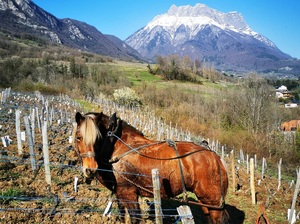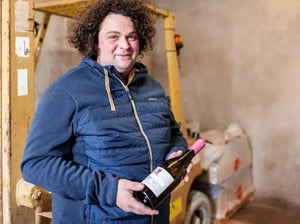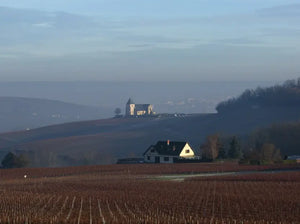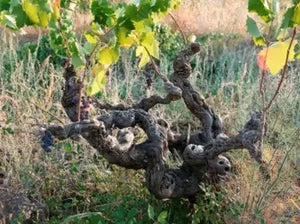Blog » Organic
-
A Star in Central Portugal: Textura
The Dão is unique. Resistant to the Atlantic influence that characterizes so many of Portugal’s wine regions, this little enclave of viticulture exists to defy expectations. One of the projects highlighting the possibilities within the region is Textura. Beginning in 2018, the project pulls from over 20 hectares of organic vineyards within two subregions: Castendo and Serra da Estrela.
The approach to winemaking at Textura shows a commitment to low-intervention practices that have served winemaker Luis Seabra well. His consultation and guidance have left their mark on Textura’s lineup, with “Burgundian” being a term used to describe the wines. Especially evident in wines like Textura da Estrela, judicious use of oak, a pinch of reduction, and natural acidity integrate into an enticing, racy wine that pairs with a huge range of cuisines.
What’s distinctly not “Burgundian” here are the grapes. While varieties like Encruzado, Arinto, and Gouveio don’t have the international recognition of Chardonnay, they deliver vibrant wines full of character.
In Dão, like so many regions of Portugal, the blend is key. The wines here are all about harmony. The floral and tea aromas, citrus, and orchard fruits like pear all emerge from the modest veil of reduction in wines like Pretexto, while the deep well of concentration present in Pura gives the impression of a wine worth waiting for, though it is singing at present.
No country has jolted our team over the last year like Portugal. Wines like those of Textura have the salinity and mineral punctuation with perfectly judged ripeness of fruit that has simply thrilled us. -
André Ostertag: Alsatian Sensation
Domaine Ostertag has long gone against the grain of Alsatian expectations, crafting dry, disciplined wines that still summon the sunshine that marks the region. His Fronholz and Grand Cru Muenchberg Rieslings especially imbue the transparency and purity of a mountain lake. These wines are a moment of clarity for Alsace!
Alsace is in the cool northeast pocket of France, and its protection from the Vosges Mountains means it receives the least amount of rainfall of any region. This abundant sunshine has long given Alsatian wines a rounded and golden orchard fruit quality, often with a dollop of residual sugar. However, several elements separate Ostertag from the norm. André studied viticulture in Burgundy and returned home in 1998 to employ organic and biodynamic principles in the vineyard. He also decided to ferment his Rieslings completely dry and age them in stainless steel.
Today, Alsace is famous for having the highest percentage of organic and biodynamic producers in France. While the quality at harvest couldn't be higher, I still find few producers that execute with the same sense of harmony that Ostertag is adored for. -
Delectable Dijon: Domaine de la Cras
In the hills above Dijon, you can find one of Burgundy's greatest inception stories. It is a fresh departure from a domaine's normal evolution, but the wines in bottle are the most thrilling element from Marc Soyard. In a short time, Domaine de la Cras has gone from obscure to having a cult following.
A little over a decade ago, the city of Dijon purchased a vineyard just outside its limits, and they essentially held a casting call to find a winemaker for the property. The criteria were: The winemaker must be young, have no family vineyard holdings, farm organically, and open the domaine for educational tours. Rent for the land would be paid to the city in 2,000 bottles. Marc Soyard, originally from nearby Jura, was chosen.
Soyard does not come from a family of vignerons but previously worked for Vosne-Romanée's esteemed Domaine Bizot, known for its rigorous vineyard work, minuscule sulfur regimen, and whole-cluster fermentation. Soyard's Pinot Noirs pulled me in for their super crunchy and unadulterated bright, red berry fruit. The aromas are intoxicating even before tasting, and whole-cluster fermentation gives these wines a lifted spice and floral character that just floored me.
His Chardonnay's offer a totally unique take on white Burgundy, coming from this long-overlooked terroir––seamless and classic.
"Cras" Rouge & Blanc are the domaine's top wines from the oldest vines on the steepest portion of En Bessy.
Coteaux de Dijon Rouge & Blanc comes from 30-plus-year-old vines planted lower on the slope, with the rouge seeing 30% whole clusters being included for fermentation in wooden tanks without any sulfur additions.
Tercet is Soyard's lone Gamay––an upfront fruity style with imperceptible tannins.
-
Young gun in Savoie: Nicolas FerrandCurious about alpine red wines? Then, you have to check out the Savoie's native red grape variety, Mondeuse. One of the best examples we’ve encountered comes from the young Nicolas Ferrand. We spread the word to as many of our customers as possible and are down to only a few cases.
Coteau de la Mort ($79) has the depth of Northern Rhône Syrah, with high-toned black cherry, black pepper, and pressed rose petals, though this Mondeuse is also surprisingly juicy and sleek. Ferrand does a semi-carbonic fermentation without any piegeage (pressing of the skins), no fining or filtering, uses minimal sulfur, and ages in larger format barrels.The cuvée's name, hill of death, refers to the ancient hillside vineyards re-planted during Savoie’s renaissance in the 1990s, thanks to early champions, like Michel Grisard of Prieuré St-Christophe, who I've written about in past offers. In 2013, the vineyard fell under the stewardship of Ferrand when starting Domaine des Côtes Rousses.
One of the Savoie’s top crus for Mondeuse, Saint Jean de la Porte has distinct red clay soils (the inspiration behind the domaine name), as well as limestone and moraine. Ferrand has farmed organically from the beginning and utilizes horses and sheep in partnership with his neighbors. He's native to the area, but his family previously farmed cattle, making him a first-generation vigneron.In the last decade, Ferrand's vineyard holdings have increased, and so has the buzz for his wines. Savoie expert and author Wink Lorch says, “Nicolas’s wines should become a staple in every Savoie wine lover’s cellar,” and we fervently agree. Coteau de la Mort is a refreshing take on Savoie history. -
Burgundy Fireworks: Yann Charlopin-Tissier
A June 2016 visit in Burgundy meant tastings with some of my favorite storied domaines like Mugneret-Gibourg and Denis Bachelet, but it was after a lunch with Jeremy Seysses at Domaine Dujac and a beautiful bottle of 1993 Clos de la Roche that I got tipped off to something happening across the street—the new Domaine Charlopin-Tissier.
Yann Charlopin-Tissier’s background is surrounded by legendary figures. His father, Philippe Charlopin, was a student of Henri Jayer as he started his own domaine in 1978. Yann worked closely with his father starting in 2004, and then with another mentor, Jean-Marie Fourrier, before launching his own domaine, now at just 4 hectares. Like these Vosne-Romanée and Gevrey Chambertin mythic names, Yann favors picking as ripe as possible and prefers de-stemming.
Yann filled me in on his methodical and organic approach to viticulture, his excruciatingly low yields, and his disdain for talking too much about winemaking choices in the cuverie. "These wines are made in the vineyard," he would repeat. And the dirt under his nails, and muddy boot prints littered throughout the courtyard drove home that point. For me, this image greatly juxtaposed with what you find in bottle––suave and sophisticated texture, luxurious mouthfeel, supported by very concentrated ripe fruit buffered with mouth-watering salinity.
My two favorite wines of the 2020 vintage capture precisely what is so special here: The Marsannay La Montagne is surely the sleeper pick in the range, but this lieu-dit coming from the top of the slope in Marsannay where it is substantially rockier than below offers a masterclass in balance, between bold, ripe, dark fruit with powdery tannins and mineral finish. The Pernand Vergelesses Sous Frétille is one of best kept secrets in Premier Cru white Burgundy. Always a site that delivers crisp salinity and a Grand Cru-level drama. Yann’s version has a ruthless intensity of fruit with a chalky grip that is truly head-turning. This reflects his ambition for powerfully concentrated wines that still somehow have a wizardly refinement on the palate. -
Pinot Meunier Whisperer: Laherte Freres
Tucked between the Côte de Blancs and the Vallée de la Marne, Aurélian Laherte has almost single-handedly put the tiny Côteaux Sud d’Epernay on the map with his truly singular and brilliant work focusing on Pinot Meunier.
This 1889-founded domaine has followed an organic and biodynamic path since Aurelian took the reins in 2005. He opts for old Burgundy barrels, partially or fully blocks malolactic fermentation, and keeps dosage between very low to zero, giving wines with body and texture but a precise and saline-driven mineral backbone—a combo that really appeals to me.
Laherte's Ultradition Extra Brut has been a house champagne for us for many years. Now, the secret is out, and we’re limited to as few as 12 bottles a year. At $53, the value cannot be overstated. There's also the micro-production cuvées from single parcels that are off the charts. -
Old-School Mt. Etna: Massimiliano Calabretta
“I make my wine like Bartolo Mascarello!” That's what Massimiliano Calabretta told his U.S. importer when they first visited his estate in Sicily. The family's formula is simple: To work with old-vine and own-rooted parcels preserved as long as possible through organic farming. Their historic practices have stood the test of time as the world around them rapidly changed. The wines at Calebretta are entrenched in tradition, just as Bartolo Mascarello would have approved.
Nerello Cappuccio is often considered a blending grape (mainly because of its viticulture difficulty and susceptibility to disease than any varietal shortcoming). Calabretta saw his old, ungrafted vines offered a very different expression of the variety, with an aromatic lift that stood apart from his counterparts: Dark red fruits, smoke, lavender, violets, and a saline-infused finish that has made reaching for this wine habitual.
Nerello Mascalese is the primary red variety on Mt. Etna. The vines for Calabretta's old-vine cuvée, Vigne Vecchie, start at 60 years old and go well over 100 years, many of which are un-grafted. Aging takes place in 50-70 hectoliter Slavonian casks for up to 42 months. This protocol draws parallels to traditional Barolo producers, but the similarities go beyond aging formats.
.svg?v=162776257677185172071724397232)









